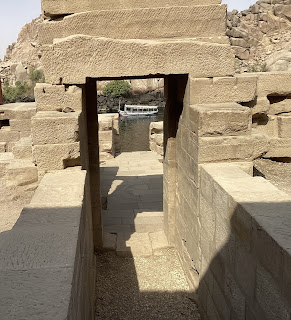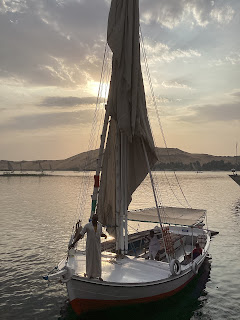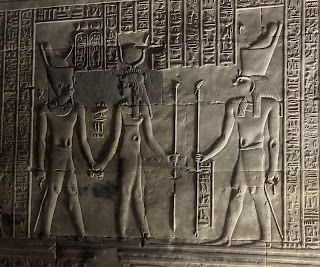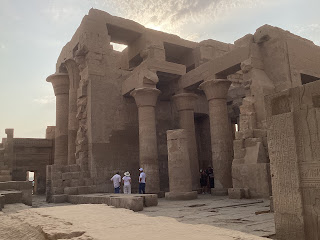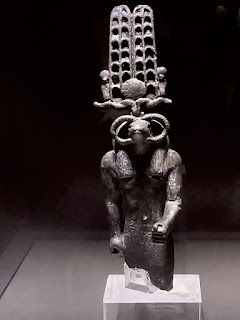Day 23
Hatshepsut the “Drag King of Egypt” woke up one morning with an idea. “I want someone to make me the biggest obelisk ever seen!” So instructions were sent to the artisans and stone masons at Aswan.
“Who sent this?” enquired the head mason (or “Grand Poobah” as he was known at the local Masonic Lodge). “The Pharaoh!” responded his offsider. “Which one? The little fella or Lola?” asked the Grand Poobah. “Lola!?” enquired his offsider. “L-O-L-A Lola!” sang the Grand Poobah. “Hahaha, like it, like it”, laughed his offsider, before himself singing, “the dude looks like a lady!” and they both fell about laughing hysterically.
So everyone at the granite quarry set to work, employing their best obelisk making techniques. They prepared the surface of the granite they had chosen and marked out the shape easily enough. Then they began creating the trenches around the obelisk without much hassle at all. But, as they began the process of freeing the shape from the quarry floor, CRACK!!!
And that my friends is what we saw today, the unfinished obelisk. Abandoned seconds after that fateful moment and untouched for the next 3500 years. I couldn’t help but think how impressive it would’ve been if they hadn’t totally botched it.
From there we headed to the Marina of an artificial lake located on the River Nile between the Aswan Low Dam and the Aswan High Dam so we could visit the Philae Temple complex.
Unlike any of the other temples we have visited, the Philae Temple complex is located on an island that can only be reached by boat. After a few minutes (spent hovering in the background as our guide Shenouda negotiated a price for the return crossing with one of the boatmen), we were on our way to the picturesque island of Agilkia.
It may interest you to know that Agilkia Island wasn’t the original location of the Philae Temple complex. The original location was another, lower-lying island, which (after the Aswan Low Dam was completed in 1902), was repeatedly hit by floods. During this time the only part of the temple complex visible to the naked eye were the tops of the columns of the Great Temple of Isis. By 1960 the rising waters of Lake Nasser were so bad they threatened to permanently submerge even the tops of the columns, so the Egyptian Government teamed up with UNESCO to save every monument of the Philae Temple complex hidden below the surface. The construction of the new Aswan High Dam during the 1970’s enabled the entire complex to be painstakingly dismantled (into about 47,000 separate sections), and rebuilt successfully on higher ground (a few hundred metres away), at Agilkia Island.
After a pleasant journey across the lake we arrived at the island for a sticky beak at all it had to offer, the most prominent thing being the Great Temple of Isis. It is quite huge and boasts graffiti from not only his soldiers, but Napoleon himself.
Apparently the little man in the big hat and the penchant for permanently scratching his left nipple with his right hand escaped to the Philae Temple complex with his troops after losing a battle during the Napoleonic Wars. Other monuments around the complex include the kiosk of King Nectanebo I (which sold coffee, falafel and shawarma), the kiosk of Trajan (which was a little more upmarket and where you could sample the specialty of the house, Trajan’s signature Philae Mignon with roasted vegetables), the gate of Hadrian (which was nothing more than something he probably picked up at Bunnings), and other temples dedicated to Imhotep (the fella who first used stone blocks instead of mud brinks and designed the Step Pyramid), Augustus Caesar (first emperor of Rome), and Hathor.
There is also another Nilometer here as well, in which is displayed an interesting cartouche explaining what the word Pharaoh means along with the last known use of hieroglyphics before the language died out and was replaced by Greek. The whole place is really impressive and the views are just marvellous.
From there we went to the Thutmose Essence Perfume Palace (basically a place that sells oil), where we vehemently swore to Shenouda that (even though we had absolutely no interest in coming here), we would just duck our heads in the door and then go. An hour and a half later we appeared with a lifetime supply of oil that I think I’ll need to leave to some poor sap in my Will. Then we headed back to our boat wondering if we will need to pay an excess baggage fee when we check our luggage in tomorrow evening.
A few hours later Maria, Wim, Shenouda and I hopped on a traditional Egyptian Felucca and enjoyed a pleasant early evening, leisurely sailing up and down the Nile for an hour or so. The perfect end to a wonderful day.
















